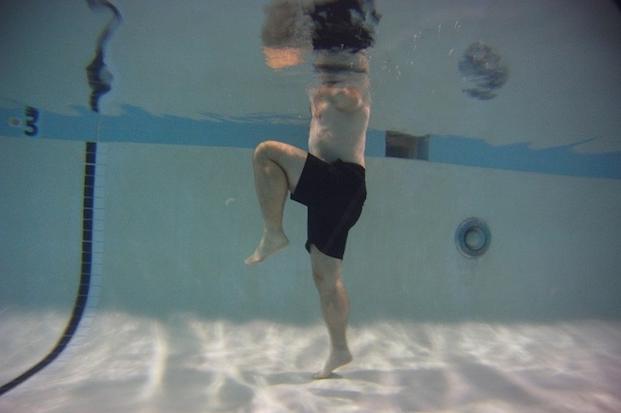Running injuries can happen to anyone, whether you're a beginner, casual runner or even an advanced or competitive runner. When recovering from one of these injuries, make sure to maintain your cardio and aerobic base with non-impact cardio options like biking, swimming, elliptical machines, rowing and aqua jogging.
Here is an email from a runner who overdid it on a running cycle and now has a stress fracture in his shin:
Stew, I have a fibula stress fracture, I am swimming everyday but would like to include some aqua jogging. Got any tips about aqua jogging? John
While it is advised to consult a doctor before beginning an exercise program, aqua jogging is a great way to work the same muscles and joints as running without the impact and with the increased resistance of water. Not only is aqua jogging a great mobility activity, but it also can be an exceptional cardio option.
Here is how you can make it more challenging.
I like horizontal swimming as a workout option, but if you are not good at swimming, do what I call "vertical swimming" and mix in treading water and aqua jogging. Make it more challenging by dropping underwater for 10 strides while holding your breath. After every 10th stride, pop up to inhale.
This workout will increase your heart rate and perceived effort levels and make aqua jogging more difficult. The goal is to have the full range-of-motion running movements with the hips and knees. The fact that you'll also be pushing a little harder to get the heart rate higher is just a bonus.
When you have a running injury, the last thing you want to add to your rebuilding phase is aerobic base and running conditioning. You can maintain your cardio fitness by getting after it through a wide variety of non-impact machines and swimming workouts.
Here is my typical non-impact day workout that incorporates flexibility and mobility:
Repeat 5 times
Bike or elliptical or swim (or aqua jog): 5 minutes
Stretch or foam roll: 5 minutes
Then:
Swim 10 minutes fast
Tread water: 10 minutes (try without using hands as it really works the hips)
Normal pre-race or pre-workout dynamic stretches in chest-deep water: 10 minutes
This last step is like aqua jogging but with many more planes and ranges of motion involved.
I think aqua jogging or treading are great training options if they're done before or after a swimming session and considered a warmup or cooldown activity from the effort given in the swim routine.
However, if you are a runner and not a regular swimmer, you may prefer to focus on running movements for a single 45-minute aqua jogging workout. If so, you can incorporate aqua jogging with a variety of cadences and effort levels.
You may want to wear or hold some form of flotation device (or aqua jogging belt) so you can focus more on the actual movements of a proper running stride, versus having to tread or float in the deep section of the pool.
Try mixing up the speed and stride count per minute if you prefer only to aqua jog. Some favorites include the following:
1 minute fast, then 1 minute easy for 20-minute sets
2 minutes fast, then 1 minute easy for 30-minute sets
Current mile pace time and cadence for 3-4 sets of mile repeats.
Depending on the injury, you can mix in some squats and lunges on the pool deck every five minutes to work the muscle strength and stamina of the legs as well.
Try the following if you are not having joint pains:
Repeat 5 times
Aqua jog: 5 minutes fast
Squats 20
Lunges 10-20 per leg
Light stretch: 1 minute
I recommend that you only do the leg calisthenics every other or every three days, depending on your abilities. You will need some recovery time from the added repetitions. However, you can aqua jog daily until you get cleared to run again by your coach or physical therapist.
Stew Smith is a former Navy SEAL and fitness author certified as a Strength and Conditioning Specialist (CSCS) with the National Strength and Conditioning Association. Visit his Fitness eBook store if you're looking to start a workout program to create a healthy lifestyle. Send your fitness questions to stew@stewsmith.com.
Want to Learn More About Military Life?
Whether you're thinking of joining the military, looking for fitness and basic training tips, or keeping up with military life and benefits, Military.com has you covered. Subscribe to Military.com to have military news, updates and resources delivered directly to your inbox.


















